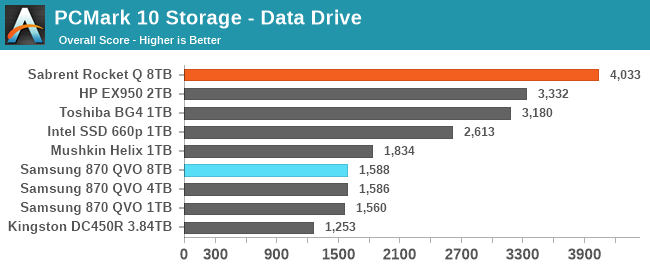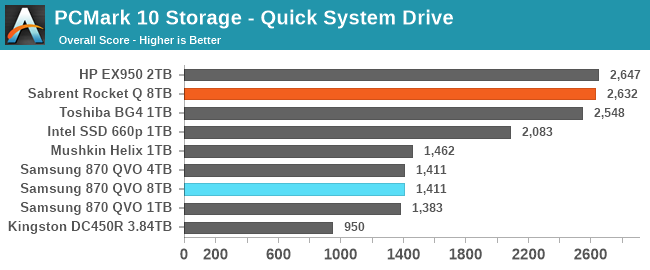QLC Goes To 8TB: Samsung 870 QVO and Sabrent Rocket Q 8TB SSDs Reviewed
by Billy Tallis on December 4, 2020 8:00 AM ESTPCMark 10 Storage Benchmarks
At the end of 2019, UL released a major update to their popular PCMark 10 benchmark suite, adding storage performance tests that had been conspicuously absent for over two years. These new storage benchmarks are similar to our AnandTech Storage Bench (ATSB) tests in that they are composed of traces of real-world IO patterns that are replayed onto the drive under test. We're incorporating these into our new SSD test suite, and including our first batch of results here.
PCMark 10 provides four different storage benchmarks. The Full System Drive, Quick System Drive and Data Drive benchmarks cover similar territory to our ATSB Heavy and Light tests, and all three together take about as long to run as the ATSB Heavy and Light tests combined. The Drive Performance Consistency Test is clearly meant to one-up The Destroyer and also measure the worst-case performance of a drive that is completely full. Due to time constraints, we are not yet attempting to add the Drive Performance Consistency Test to our usual test suite.
| PCMark 10 Storage Tests | ||
| Test Name | Data Written | |
| Data Drive | 15 GB | |
| Quick System Drive | 23 GB | |
| Full System Drive | 204 GB | |
| Drive Performance Consistency | 23 TB + 3x drive capacity | |
The primary subscores for the PCMark 10 Storage benchmarks are average bandwidth and average latency for read and write IOs. These are combined into an overall score by computing the geometric mean of the bandwidth score and the reciprocal of the latency score. PCMark 10 also records more detailed statistics, but we'll dig into those in a later review. These PCMark 10 Storage test runs were conducted on our Coffee Lake testbed:
| AnandTech Coffee Lake SSD Testbed | |
| CPU | Intel Core i7-8700K |
| Motherboard | Gigabyte Aorus H370 Gaming 3 WiFi |
| Chipset | Intel H370 |
| Memory | 2x 8GB Kingston DDR4-2666 |
| Case | In Win C583 |
| Power Supply | Cooler Master G550M |
| OS | Windows 10 64-bit, version 2004 |
Data Drive Benchmark
The Data Drive Benchmark is intended to represent usage a secondary or portable drive may be subject to. This test simulates copying around files, but does not simulate the IO associated with launching and running applications from a drive.
 |
|||||||||
| Overall Score | Average Bandwidth | Average Latency | |||||||
Starting off, the 8TB Sabrent Rocket Q leads the field thanks to its massive and fast SLC cache; it clearly outperforms even the decently high-end 2TB TLC-based HP EX920. The several capacities of the Samsung 870 QVO all performa about the same: less than half the speed of the faster NVMe drives, and slower than the slowest entry-level NVMe drives. The enterprise SATA drive with no SLC caching comes in last place.
Quick System Drive Benchmark
The Quick System Drive Benchmark is a subset of the Full System Drive Benchmark, running only 6 out of the 23 sub-tests from the Full test.
 |
|||||||||
| Overall Score | Average Bandwidth | Average Latency | |||||||
Moving on to the Quick test, the Sabrent Rocket Q no longer stands out ahead of the other NVMe drives, but still offers decent performance. The performance gap between the NVMe drives and the Samsung 870 QVO drives has narrowed slightly, but is still almost a factor of two.
Full System Drive Benchmark
The Full System Drive Benchmark covers a broad range of everyday tasks: booting Windows and starting applications and games, using Office and Adobe applications, and file management. The "Full" in the name does not mean that each drive is filled or that the entire capacity of the drive is tested. Rather, it only indicates that all of the PCMark 10 Storage sub-tests are included in this test.
 |
|||||||||
| Overall Score | Average Bandwidth | Average Latency | |||||||
The Full test starts to bring the downsides of QLC NAND into focus. The Sabrent Rocket Q is now the slowest of the NVMe drives, only moderately faster than the 8TB Samsung 870 QVO. The 1TB 870 QVO is also falling behind the larger and faster models. However, the QLC-based Intel 660p manages to hold on to decent performance, possibly a result of the class-leading SLC cache performance we usually see from Silicon Motion NVMe controllers paired with Intel/Micron flash.










150 Comments
View All Comments
Beaver M. - Saturday, December 5, 2020 - link
Just imagine it as 4K random on steroids.Games load MUCH faster and with less or even no stuttering.
Its been proven already. If you want to miss out on this, thats your choice.
Deicidium369 - Sunday, December 6, 2020 - link
Proven already is a bit premature. Transferring compressed data to the GPU which then decompresses is going to be an obvious increase in performance - provided it is not left up to developers to implement - like multi GPU being a part of DX12 - but only if it is implemented.Beaver M. - Monday, December 7, 2020 - link
Its working on consoles already. And of course the devs can choose to use it or not. But since its part of consoles, and most PC games are console ports, its very likely to be very common in the future.Spunjji - Monday, December 7, 2020 - link
It's going to affect performance plenty for people who run software that uses it. Your personal attitude to new games and their "political" content doesn't really have any bearing on that.Oxford Guy - Friday, December 4, 2020 - link
"Flash memory prices have been on a downward trajectory for years."And now, thanks to QLC, quality, too!
Spunjji - Monday, December 7, 2020 - link
How many posts do you need to make the same point?Oxford Guy - Monday, December 7, 2020 - link
When QLC is no longer being shoved down my throat? 0.inighthawki - Friday, December 4, 2020 - link
One additional purpose for high capacity M.2 drives is that they're compatible with the new RTX IO/DirectStorage requirements (NVME drive over PCIe), which will not work on a standard SATA drive. So if you have a lot of large games that you want to be able to take advantage of this feature, you will need higher capacity drives.And yes for many people 2TB or 4TB will be more than sufficient for this, at least within the next few years until games more commonly adopt the feature. I'm by no means calling this a requirement for anyone, just merely pointing out an upcoming use case.
DigitalFreak - Friday, December 4, 2020 - link
My 860 EVO 4TB is humming along just fine for now. Still costs the same as what I paid for it a couple of years ago, which is a joke. I'm waiting for DirectStorage before I buy another high capacity drive for games. By that time PCIe 4.0 drives should be more commonplace, and hopefully cheaper.DigitalFreak - Friday, December 4, 2020 - link
BTW, excellent article Billy.